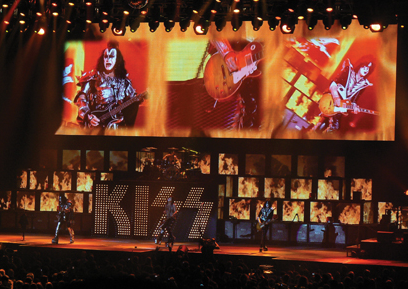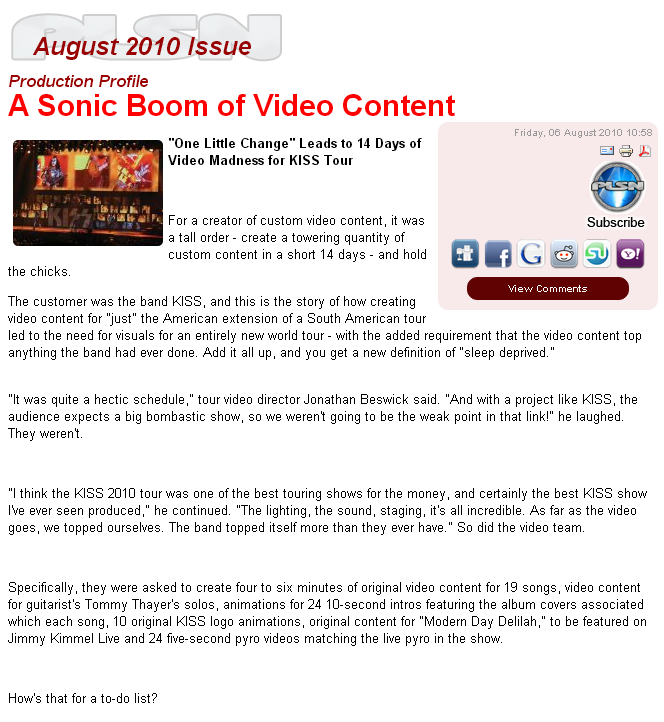PSLN MAGAZINE
August 2010- KISS- Sonic Boom Tour

“My Reality”
Jonathan Beswick cut his video teeth on the first Simon & Garfunkel reunion tour in 1984. For several years he worked with Nocturne Video on various projects, including this one. He often worked with Mark Devlin of Mark Devlin Visual Design.
Devlin, a graphic designer, started an ad agency in Los Angeles right out of art school, but his medium evolved into motion graphics. His path crossed with Beswick in 2004, who was working with Tommy Thayer at the time. Thayer, in addition to being KISS’ guitarist, was producing projects for other artists as well. Devlin was called in to do an opening video for Ted Nugent. KISS “saw my stuff,” Devlin said, “thought I was good, and wanted me to create some stage videos for their Rock the Nation tour. Needless to say, I shot up!”
Then he was shot down again when he learned what frontman Gene Simmons wanted to pay him: an underwhelming $250 a piece for six original videos. When Devlin protested, Simmons said that he could go out and “find 10 guys on the street right now that will do them for free.”
“I said, ‘Alright, it’s bull**** money, but I’ll take it.'” And thus his first, but not his last, work for the band began. (Beswick and Devlin continued to work on other projects, including Journey, Fall Out Boy and Def Leppard).
Fast forward to February of 2009, when Beswick called on Devlin for a South American KISS tour. It proved to be a false start, as Thayer decided to take care of the video content duties himself. But that tour was so successful that a tour of the States was being planned, and in August 2009, Devlin was put to work on that tour leg. Meanwhile, in the upper echelon of KISS management, conversations were taking place about how to make this tour bigger and better.
“Right when I was about to send them my proposal, I got e-mails from every person in the KISS organization that there’s been a ‘slight’ change,” he said. Everything was changed – from the set list to the costumes. “Then, everything we had was scrapped, and we had to start all over again.”
“There were design ideas floating around at the end of the South American tour,” Beswick added, “and subsequently everything got blown out the door.” But he and everyone else loved the new set. “My hats off to [scenic designer] Patrick Whitley. He gave us an amazing palette to work with.”
Along with that, there would be 52 three-foot-square V9 LED screens at 96-by-96 pixels spread throughout the set. “It was beautiful because it hadn’t been done before,” Devlin added.
The new direction and the bone-crushing deadline also came with a special request from Simmons: “I don’t want to see any images of sexy girls,” he told Devlin. “This is the new band. We’re mature. There’s no strippers on stage, so no images of chicks on the videos.” A tried-and-true failsafe fall back visual was off the table.
Devlin knew just what to do first: “I stepped outside and had a panic attack.” Beswick was there to talk him off the ledge. He calmly explained that this was the budget and the time frame, and it was going to get done. Devlin credited him with having faith and talking him into “accepting the situation as my reality.”
All About the Math
Then he grabbed a pencil. “From a designer standpoint, you first put together a production schedule. Let’s count how many hours are in those 14 days. Then we saw that a video where we would normally spend seven to 10 days, we’d now spend seven to ten hours on it. Just 24 minutes was scheduled to do a five-second intro. It became all about the math.”
And that also included subtraction: they decided the band wouldn’t see anything until it was too late to change.
Some of Beswick’s prayers were answered in the form of a talented artist hungry enough to work for free. Devlin was skeptical. This was someone, after all, who was in Tulsa, Okla. But Devlin was blown away by Kyle Stauffer’s graphic work, and impressed that he could also do 3D animation. “So I threw him into the same fire,” Devlin said. “I gave him [an assignment] with no direction, total freedom. The next afternoon I got exactly what I wanted. Kyle throughout came up with some amazing concepts.”
Beswick said one of the highlights was how the video matched the live pyro. Working at “Pyro Pete” Cappadocia’s shop in Albuquerque, they shot the exact explosion that was designed to go off during the concert with an HD camera, and synched it with the real thing in the show.
“The challenge was just keeping up the pace,” Devlin said. “I would come up with a concept, search for material, and then at some point you literally have three minutes to come up with whatever you can. If I wanted 100 elements for something, but the time was up and I only had seven, I just used what I had and moved on.”
He did manage to save some time by using a plug-in for After Effects called ParticleIllusion. It was a “grab-and-go technique” with one notable exception: he wanted to do something special for what would become the Delilah video.
“It was going to be seen on TV, it was going to be part of the music video, so I didn’t want to limit myself to seven to 10 hours of work on it.” So he gave himself a “whopping” 14 hours, and it was the last thing he did.
“I kind of felt that classic rock ‘n’ roll solutions were harder to do, so I looked at Beyonce, Usher…and saw the high energy stuff they do where they put just about anything on the screen whether it makes sense or not. And I thought, ‘That’s what I’m going to do.'” He credited his library of visual candy as being a great resource for the snow, spinning clocks, targets, and more for the grab bag of visuals that appear in the video. But it wasn’t totally random: he constructed it like the song was constructed. Visuals for verses were repeated, as were visuals for the chorus and so on.
Calling on Dr. Love (Or Any Doc)
One of the many things the schedule didn’t allow for was sleep. For the first 10 days, he slept about four hours a night, and the last four days he was pretty much awake the entire time.
Meanwhile, the band noticed that they hadn’t seen any finished content and mentioned it to Beswick. “Jonathan was very professional and just explained that they can have the content on time, or they can review it,” Devlin said. “He just told them that there was simply no time to put it up on a site for review.”
Finally, a day and half before the first date of the tour, the band got to see some of it. They were impressed enough that they agreed with the designers to stay out of the way so that it could be finished.
But it was a close shave indeed. On the night of first show, the opening band ended at 8:20, Devlin arrived at 8:30, and director David Neugebauer uploaded it in time for the 8:40 start of the world tour.
Beswick was originally approached to be the touring video director, but he had a prior obligation with Def Leppard, so Neugebauer stepped in. “He pulled it together and ended up adding a few tricks of his own,” he said. “He did a fantastic job. Also, Nocturne Video supplied amazing products and their crews are second to none. Without that crew, this show could not have been pulled off.”
Beswick added that they were also prepared for changes. “Nobody sticks to the set list,” he points out. “They move things around, add and drop songs, so you have to be prepared with some generic content. But Dave also found some footage and manipulated it in ways that made it look like the original content we supplied and filled in any gaps. He was an integral part of keeping the ship running.”
As for Devlin, after the first show, he went home and collapsed with a fever of 102°.
KISS Tour, 2009/2010
Crew
Tour Manager: Patrick Whitley
Video Content Producer: Jonathan
Beswick
Video Content Art Director: Mark Devlin
Video Content Designers: Kyle Stauffer, Lee “Rod” Roderick
Editor: Benjii Gillespie
Lighting Director: Sean “Motley” Hackett
Video Director/ Programming/TD/
Media Tech: Dave Neugebauer, 2009;
Jerry McReynolds, 2010
System Engineer: Stefaan Michaels, 2009; Roy Fountain, 2010
Lead LED Techs: Justin McLean, 2009;
John McLeish, 2010
LED/Cam Op 1: Brian Bateman, 2009;
Kevin Paul, 2010
LED/Cam Op 2: Chris Kemp, 2009/2010
LED/Cam Op 3: Michael Sienkiewics, 2009; Mike Johnson, 2010
LED/Cam Op 4: Matt Howe, 2010
LED/AD, Programming/Media Tech, Medialon Operator: Gene McAuliffe, 2009
Video Gear
4 Doremi Labs NuggetPros
2 DoremiLabs V1x2
2 Vista Systems Spyders
GVG Kayak HDD150 switcher
4 Ikegami HL65 cams
Barco 20K video projectors
2 27’x18′ video screens
1 58’x18′ Vidicon V9 LED display wall
52 36″x36″ V9 video displays
2 48″x96″ V9 video displays
